
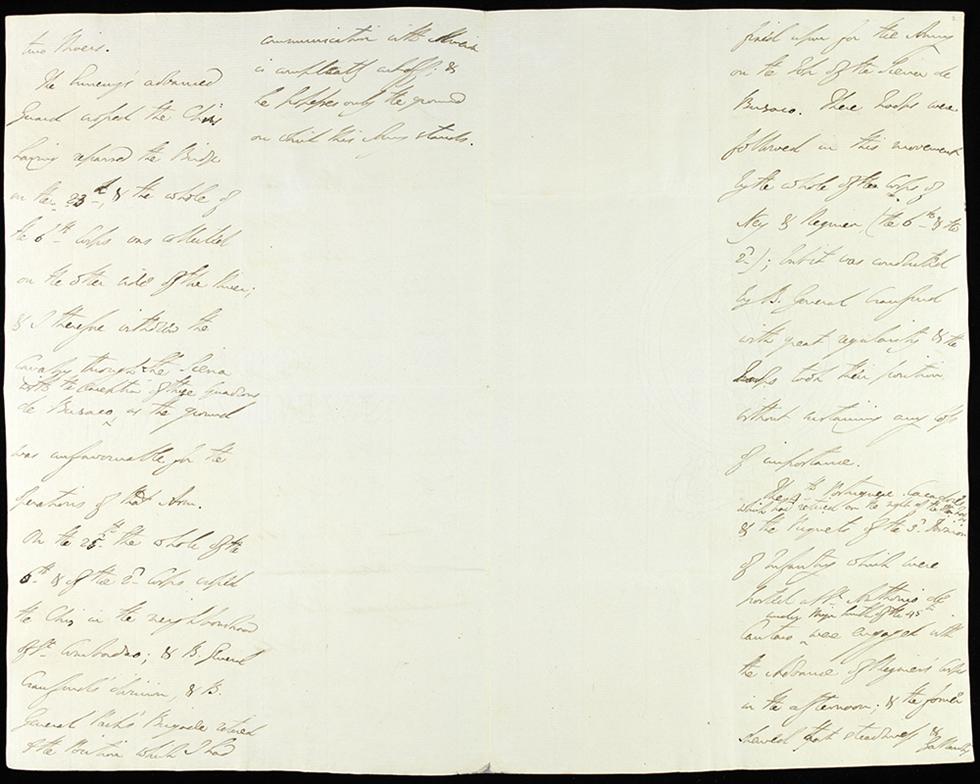
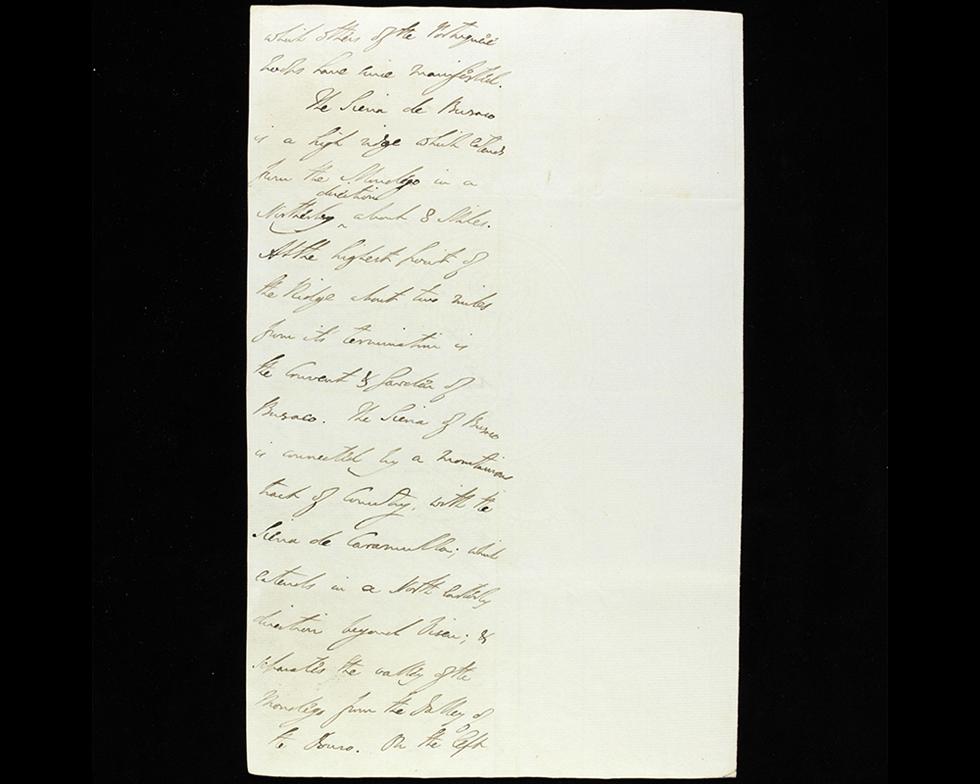
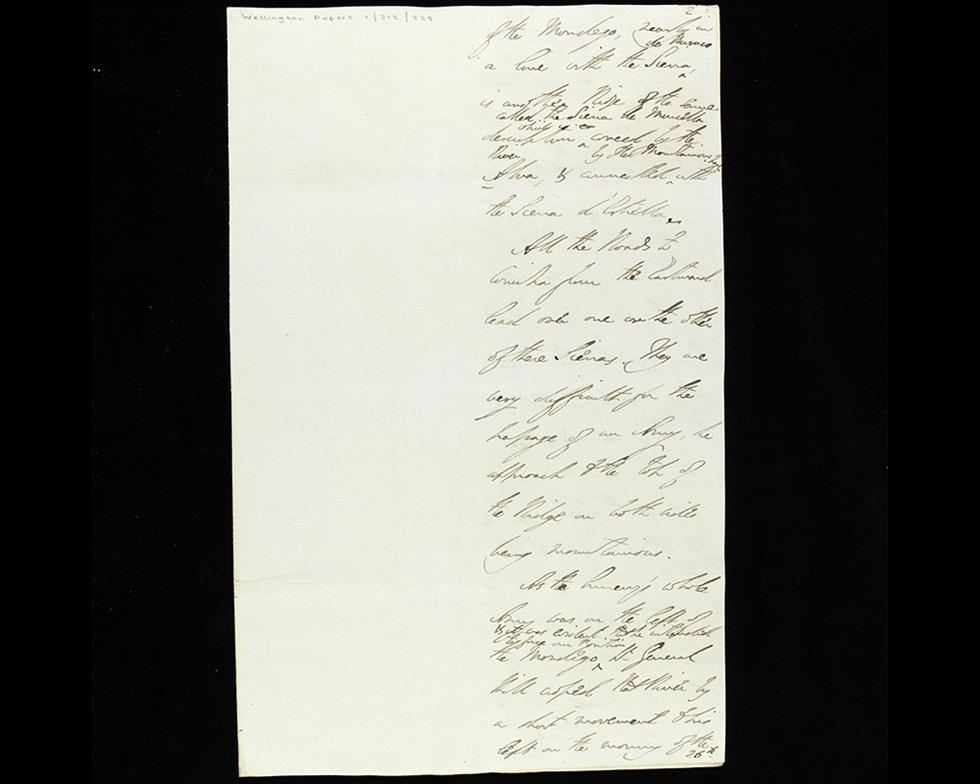
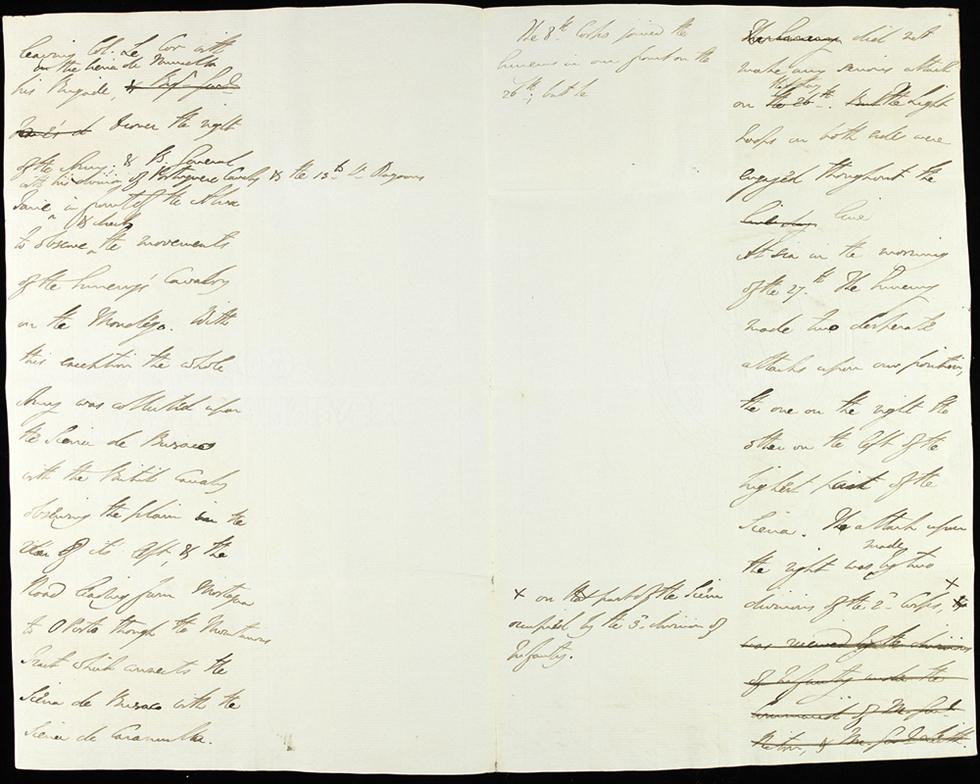
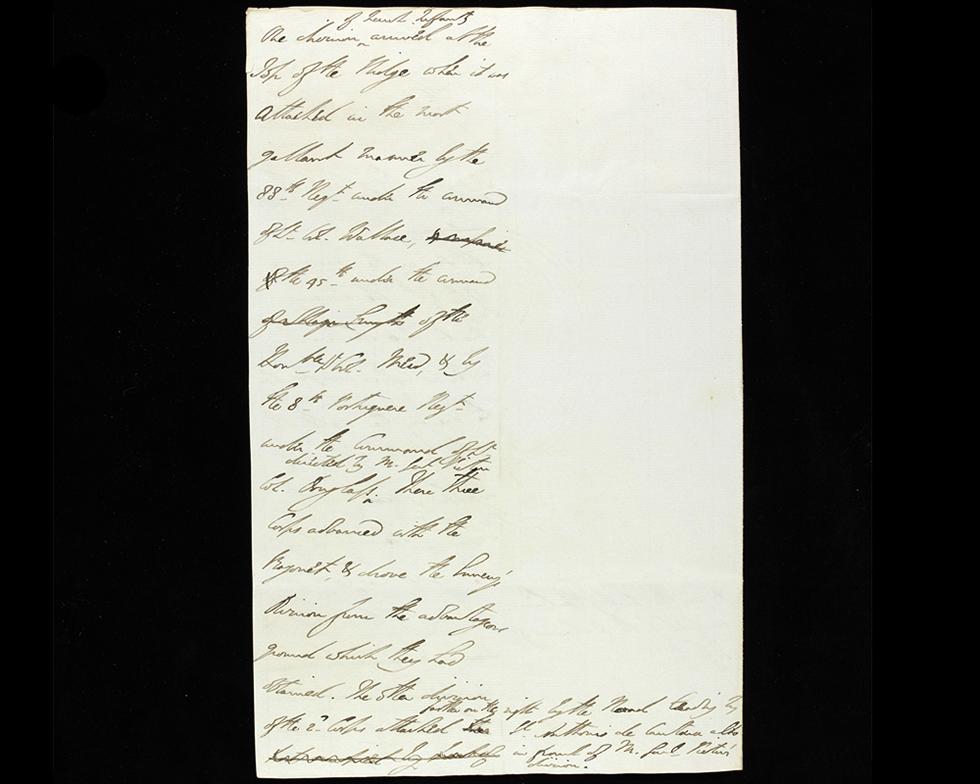


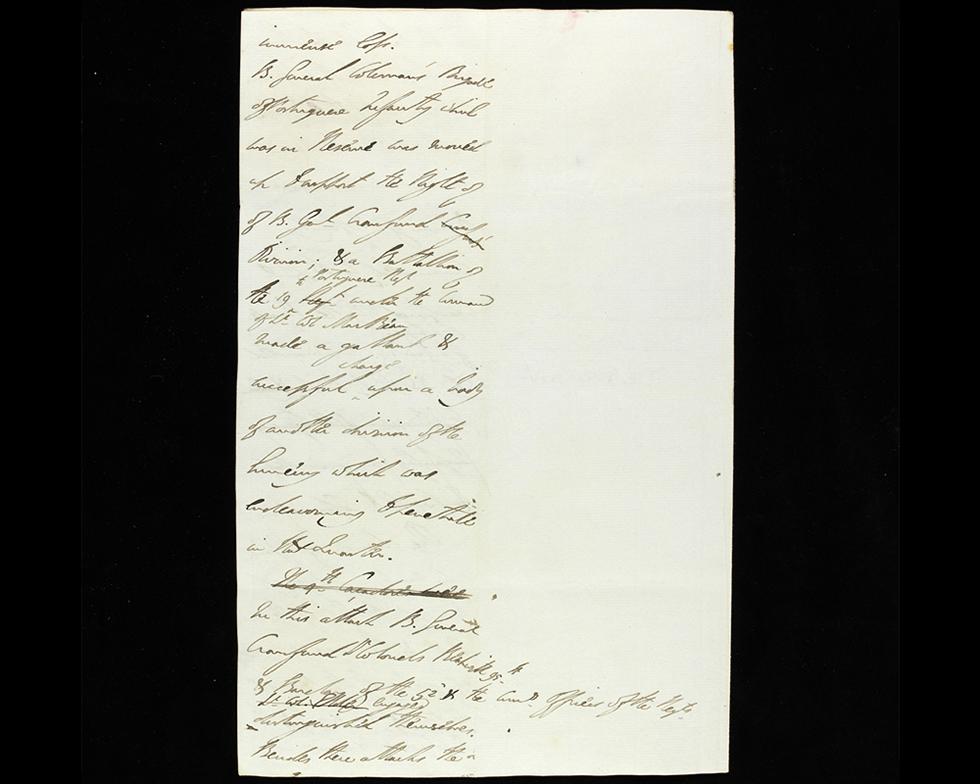
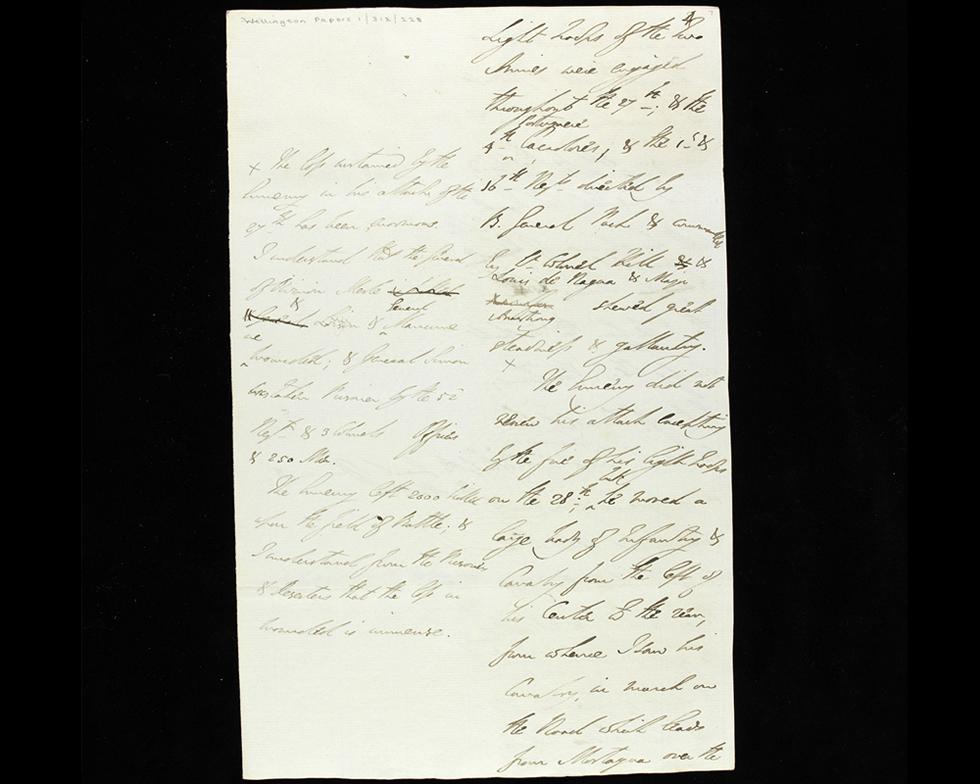

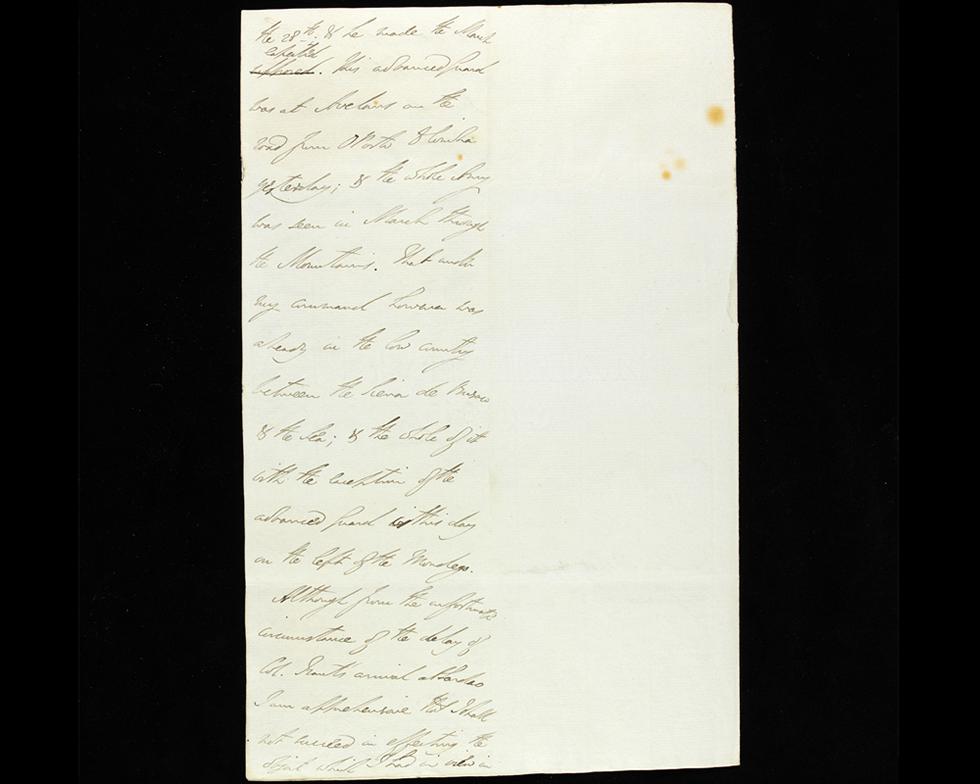

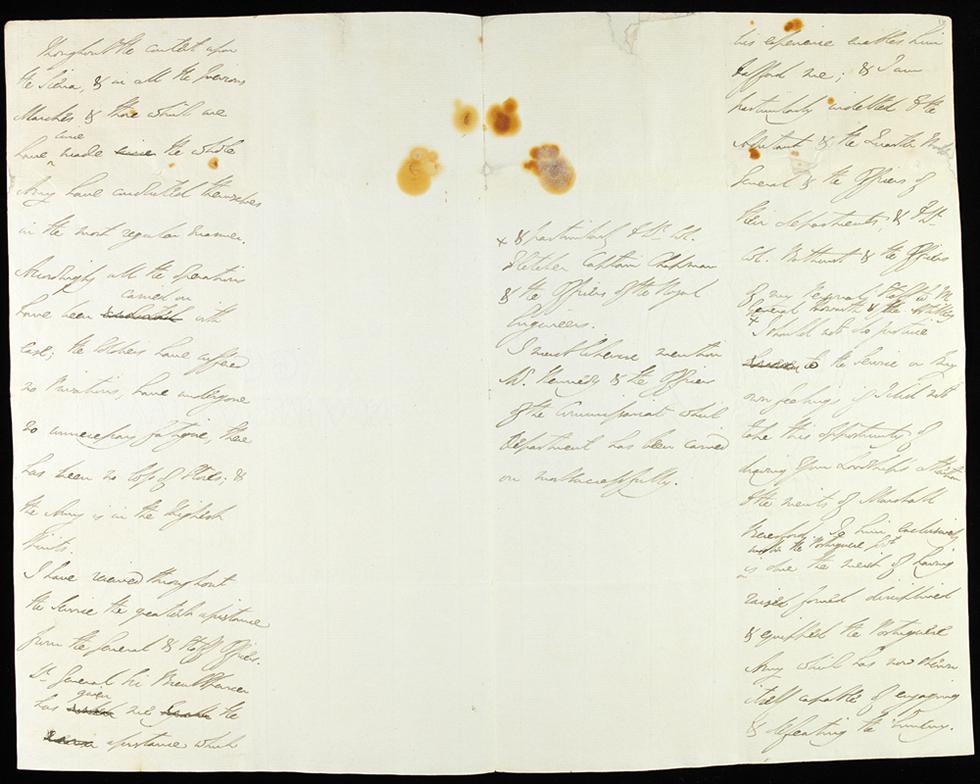
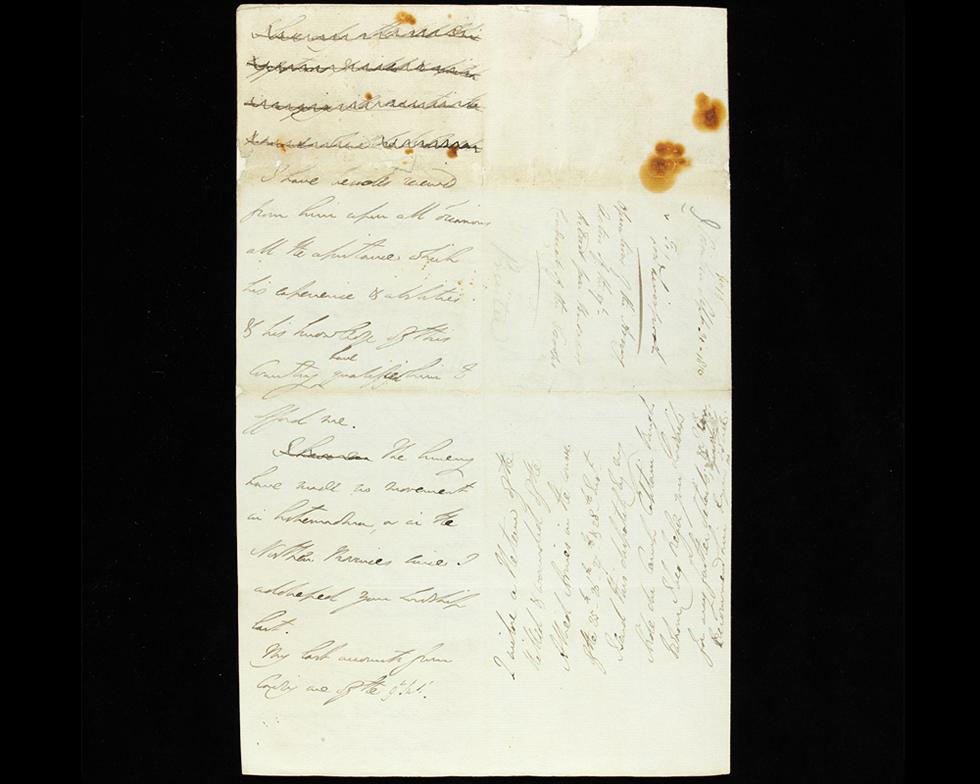
The Busaco despatch of 30 September 1810 is among the papers of the first Duke of Wellington (Wellington Papers 1/312/228), in the Special Collections Division of the University of Southampton Library.
Wellington reported the battle of Busaco in his despatch to Lord Liverpool, the Secretary of State for War and the Colonies, on 30 September. It was part of Wellington’s routine duties to communicate formally with the Secretary of State in London. There was a regular correspondence, with the Duke writing back anything between once a week and once a fortnight, sometimes more often if there were events of significance — but writing even if there were not. The despatch was a formal communication, which could be called for by Parliament. The writer had to be able to substantiate its contents, and in composing despatches after battles Wellington relied on formal reports from his subordinates. After major actions, the despatches typically contained an account listing those responsible, the part they had taken, or that of the troops they had commanded; and the despatch usually contained, or enclosed, a list of casualties. After a major battle, it was traditional that the despatch would be taken back to England by an aide de camp, who might receive promotion as a result.
Wellington’s narrative of the action almost always included a description of the topography. One of the striking features of his work is that, as in the case of Busaco, these sections were almost always written with little amendment or alteration — that is, he wrote them down as he composed them in his mind — the clarity of his understanding of the geographical context is remarkable. The sections describing the action itself almost always caused the Duke more trouble, and we find these sections written and rewritten, as he sought to work in the accounts he received from his officers. Wellington’s drafts, when complete, were copied out fair by his aides de camp, and the Duke signed the final version ready to go off to London.
The despatch is reproduced with the permission of the Controller of Her Majesty's Stationery Office.
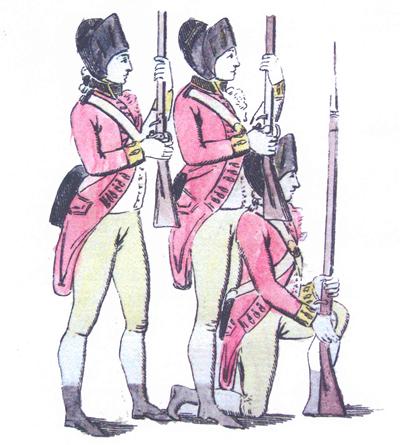
Between the outset of the French Revolution and 1815, Britain was almost continually at war, first against the armies of revolutionary France, and subsequently, against Napoleon and the combined forces of his empire. If the wars of the revolutionaries were initially confined to Western Europe, with the coming to power of Napoleon the conflict became worldwide in its scale and far-reaching in its consequences. Britain’s forces, especially her navy, were engaged in this struggle from the Low Countries to South America, India and the Far East. Her army played a major role in the Peninsular War — the campaigns against the French fought in Spain and Portugal from 1808 to 1814. British support for Spain and Portugal, both occupied by the French, was critical in the overall defeat of Napoleon. To Spaniards, this is la Guerra de la Independencia — the war of independence; to the Portuguese, it is the legacy of invasions in 1807–8, 1809 and 1810–11. In both countries, large areas were devastated, civilian populations were terrorised and uprooted, and there was massive dislocation to ordinary life. 1810 marked the nadir of the war for Britain and her allies in the Peninsula. Despite major victories in 1809 and 1810, there was a period of defensive stalemate; but the mere fact that an army of British redcoats survived, combined with a resurgent Portuguese army and militia, and Spanish anti-French forces, was of great significance in the long term.
The war in the Peninsula was the setting for some of the most important engagements fought by the British army in the nineteenth century. Led by Sir Arthur Wellesley, the future Duke of Wellington, Britain’s troops and those of her allies acquired an enviable reputation and inflicted a succession of defeats and stalemates on the French. As part of the events commemorating the bicentenary of the Peninsular War, Wellington’s despatch for one of the most important of the engagements of 1810, the battle of Busaco, is presented in this on-line exhibition.
Wellington remarked in April 1809 of the Portuguese forces that they ‘are but in their infancy in respect to organization, discipline and equipment, and it is not with troops in this state that any reasonable expectation can be formed of success against the veteran and disciplined troops of France ...’: these troops were, however, central to his strategy was the development of the Portuguese army, so that it could be integrated with the British. A good deal of progress had been made by 1810. At this point, Wellington had about 31,000 British troops in the Peninsula. That summer, there were probably some 26,000 Portuguese regular soldiers, and the Portuguese militia and ordenanças — a levée en masse, in which all free men between 16 and 60 were required to serve at their own expense — may have totalled about 45,000.
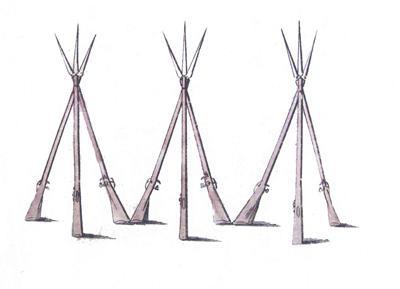
The French invasion of Portugal in the summer of 1810 was led by Marshal Masséna, who brought with him French forces in excess of 60,000 men, and there were other French armies in Spain; but there were few Spanish forces that could be brought to assist Portugal. The armies of Patriot Spain encompassed veterans from the former forces of the Spanish Bourbon kings, along with substantial numbers of levies, perhaps little better than armed civilians. The French offensive in Andalusia at the start of 1810 defeated the principal Spanish army, about 30,000 men from the Army of La Mancha, and the military resources of the Junta Central, which had overseen resistance to the French, were almost at an end — as was the Junta itself.
Revolutions in Latin America meant that the Spanish government lost much of its revenue. The cause of Patriot Spain was paralysed: there was neither funding nor logistical support for its armies. At the same time, the anti-militarism of the liberals who dominated the Patriot side impeded measures that might have made their army an effective fighting force and focused attention instead on military and other privileges. Against this background, guerrilla forces made a contribution that the regular army could not, tying down large numbers of French troops. The Portuguese were thus heavily dependent on Wellington’s army, and the strategy that he developed for the defence of their country.
A key element in Wellington’s strategy was the strengthening of defensive positions against the French, in preparation for falling back on Lisbon, if it should not prove possible to keep the French at bay either in Spain, or on the frontier. Lisbon was to be protected by a series of defensive works — the Lines of Torres Vedras — and the countryside in front of them was to be denuded of all resources. At the same time, preparations were made for guerrilla war in the area.
The Lines of Torres Vedras consisted of two series of defensive fortresses, stretching from the Tagus in the east to the Atlantic in the west. Under great secrecy, construction started in late 1809. The elaborate series of fortifications was protected to the north by further defensive measures. Roads were prepared to enable defenders to move swiftly from one part of the fortifications to another. The fortifications were ready by the late summer of 1810, when Masséna invaded. After the battle of Busaco, they were crucial in holding off the French for a period of about six months. Starved of resources in the desolate lands in front of the Lines, Masséna withdrew into Spain in March 1811.
Although the British had blocked two of the routes into Portugal from León, across Beira, a third, less likely route was available. It was this that Masséna took in the summer of 1810. An engagement took place on the River Côa on 24 July, but the French were able to advance on the border fortress of Almeida. Almeida was destroyed in a massive explosion on 26 August, removing the last substantial obstacle to an invasion. The French, however, did not start to move further into Portugal until mid-September. Knowing that other routes were blocked, they took a difficult road that led them to the Serra do Buçaco, which they had to cross if they were to get to Coimbra.
Wellington retreated from the Portuguese frontier, with the knowledge that the Lines of Torres Vedras were available to protect Lisbon. It seems probable that he had always intended to fight the French before he reached the Lines, and he would have considered the possibilities for a strong defensive position — exactly as provided by the great granite ridge of the Serra do Buçaco, running for some nine miles north south, to the north-east of Coimbra. On 25 September 1810, Masséna realised that he was heading straight for Wellington’s Anglo-Portuguese force; he knew it was a substantial one, in fact some 52,000 men with 60 guns. He had probably not expected to find the allied army blocking his way and it took him until 27 September to prepare his forces to attack the ridge. Wellington had the advantage of the ground: at the base there were woods and steep gullies, and it was steep with rocky outcrops further up. The allied forces on the crest overlooked the French, and they were also out of reach of French artillery fire. Masséna, without experience of fighting the British, decided to attack head on. The infantry led by Ney and Reynier suffered heavy casualities, losing some 4,500 men, whereas the British and the Portuguese lost 1,252.
After the battle, it became apparent to Wellington that he risked being outflanked by the French, and he therefore manoeuvred and withdrew towards the Lines.
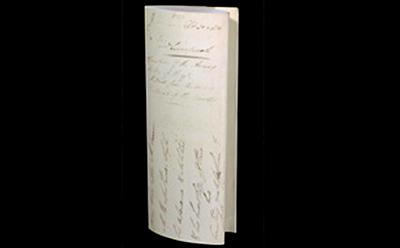
The Busaco despatch is written in the Duke’s own hand, on five sheets of paper folded into two, to produce twenty foolscap pages. It is laid out in a manner typically employed for drafts of official documents of the time. The writer folded the sheet in half vertically, and used the outer half of the paper for his text, using the part closest to the fold for insertions and deletions. The amendments fall into two principal categories: major changes to the composition, with substantial insertions and deletions; and a serious of minor, verbal adjustments that the Duke made probably on reading it through quite close to finishing the document. Like most of Wellington’s despatches of this date, it is written on British paper, supplied for the public service, with a distinctive Britannia watermark.
The formal despatches can be distinguished among Wellington’s correspondence by their salutation: ‘My lord’. Like many officials, both civil and military, he also maintained a parallel, private correspondence (all starting with the words ‘My dear lord’), which conveyed information of great, and sometimes essential, interest but which was not intended for public exposure in Parliament.